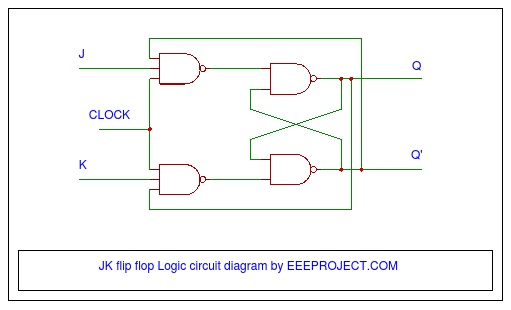

The circuit can be built on general purpose PCB or breadboard. 2: List of Components required for 555 IC based D Flip-Flop Here is the list of required components.įig.

The circuit is very easy to build and all the components are also easily available and cheap. 1: Table listing LED Statuses for Logic Levels of 555 IC based D Flip-Flop Different color LEDs are used for input-output logic indications. SPDT switch is used to give D input as logic 1 (high – 5 V) and logic 0 (low – 0 V). The flip-flop is built using four 2 input NAND gates, one NOT gate and clock pulse generator is built using multivibrator chip IC NE555. Here, the given circuit demonstrates the operation of D flip-flop. It’s widely used in memory storage devices. Actually, it latches the input to output when the clock is applied. It is called 1-bit register and stores 1-bit information when a clock pulse is applied. If you are not comfortable with asynchronously clocking the D-FF, you could synchronize the whole thing using a master clock (which needs to have a frquency considerably higher than the individual clocks) and a few additional flip-flops to put all signals in sync.D flip-flop is used to store 1-bit information. It will fail, however, as soon as two or more clock signals are active (1) at the same time because Din_FF then represents the combination of more than one data input. This state is latched into the D-FF by the combined clock signal.Īs long as you can ensure that only one clock is active a a time, this will work.

The state of the data lines where the clock is inactive is ignored (0*D)=0. This should work in the following manner:ĭin_FF is the state of the data lien associated with the active clock (1*D)=D. using an RC delay element) where xx > delay of the logic gates for FF_Data + Setup-Time of the D-FF If you are comfortable with a bit of asynchronous logic, you could build the functio9n from these equations and a single D-FF:įF clock: ClK_FF = (Clk1 + CLK2 + CLK3) delayed by xx nsįF data: Din_FF = (Clk1*D1) + (Clk2*D2) + (CLK3*D3) What would you use such an FF for? You'll never know from the state of the Q output where it comes from (the combination of D1/Clk1 or D2/CLK2 or D3/Clk3)!


 0 kommentar(er)
0 kommentar(er)
